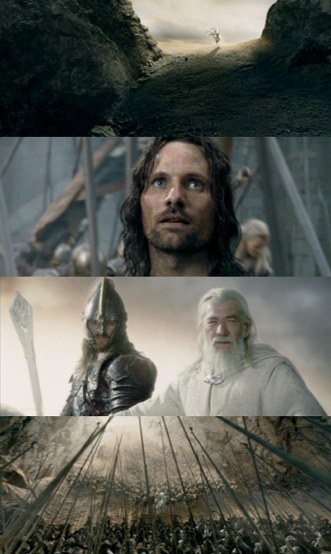
Joseph Pearce, who spoke recently at Assumption Grotto Church in Detroit on the subject of Tolkien's novels, The Hobbit and The Lord of the Rings, argues compellingly that Tolkien's works and the characters in them represent a sort of parallel history of redemption, although he didn't use the word, a parallel 'Gospel,' as it were. He has two books that elaborate this thesis, one on Frodo, the other on Bilbo. Very interesting. I'm struck by how so much in his work reads, in places, like a commentary on our own times:
'What about Rivendell and the Elves? Is Rivendell safe?'In many ways, Tolkien created the classic Anglo-Saxon Catholic myth, a myth for the English-speaking people, a Catholic myth that has its own truth by representing a parallel to another great 'myth,' the greatest 'myth' of all, the 'myth' which turns out to be true; that is, true history from God's point of view: the Bible.
'Yes, at present, until all else is conquered. The Elves may fear the Dark Lord, and they may fly before him, but never again will they listen to him or serve him....
'Indeed there is power in Rivendell to withstand the might of Mordor, for a while: and elsewhere other powers still dwell. There is power, too, of another kind in the Shire. But all such places will soon become islands under siege, if things go on as they are going. The Dark Lord is putting forth all his strength.'
The world we live in is falling into darkness; and the darkness cannot be understood spiritually without penetrating behind the scrim that divides us from the unseen world of principalities and powers at war in the spiritual world. Tolkien takes us there if we have eyes to see. What he shows us is that there is always hope; but our true hope does not always lie in the world around us and the temporal means at hand. There are powers we haven't the means to resist within ourselves. But there are powers greater than those of Mordor for those with the spiritual discernment to understand this truth.

6 comments:
There is a weakness to this argument: Rivendell, the shire, etc are all sources of good, though they may be conquered by evil from the outside. Evil rarely infiltrates those places or grows from within.
But the Church, for which these places are the obvious symbols, is rife with evil. Evil oozes out of the modern Church like syrup oozes out of a short stack that my 7 year old goddaughter prepares to wolf down.
Anecdotal evidence with a susurration of explanation: I got a fall/winter
catalog from the humble Daughters of St Paul today. They are a wonderful group of sisters dedicated to spreading the good news of insipidization to a world hungry for junk food and lies.
In the Pauline Books catalog is a categorized index of all of their publications. In the index, under the category heading CHURCH DOCUMENTS, are the following sub-categories: Pope Francis, Pope Benedict XVI, Pope John Paul II, Pope Paul VI, and Vatican II. That's all, folks!
Get it? There ARE no church documents prior to the Gangrenous Council. There is no Pre-Metastasis Church.
It is surprising that these sisters retain a pre-metastasis saint as their figurehead.
From what I have read, Tolkien, a devout Catholic, saw it all happening and had much the same reaction to it as Evelyn Waugh. If God had granted Tolkien time to write another book, I wonder how his vision of evil might have evolved.
LBG (eeeewww! That sounds like the initials for something else. Ugh. Sorry.)
Always good to hear from you, my friend; however, I think I read the 'falling under a cloud' vision a bit differently, as including not only the corruption of the political establishment but that found now in large mordant parts of the church establishment.
I get the inadequacies of the Rivendell and Shire comparisons as comparisons with the Church, for those reasons; but I wonder if the Shire isn't more like the prelapsarian Paradise, in some (not all) ways. None of Tolkien's icons is a one-for-one likeness with any Biblical image. In some ways Gandalf is a Christ figure. In other ways, Aragorn. In still other ways, Frodo. But not whole and entire. Even the ring changes significance from The Hobbit to LOTR. In the former it's a harmless tool for good -- to escape evil. In LOTR, it symbolizes sin. The imagery is therefore dynamic, not static; suggestive, not fixed.
Like the daughters of St. Paul's catalog, I find some of my colleagues assigned texts seem to quote no Church documents in their footnotes before the 'Bestest Council Ever,' to quote our friend, the Amateur Brain Surgeon.
Thanks for writing, as always. I couldn't think of a better way to spend November 8th than with him and you and a few good bottles. Would be fun.
And Rahner spake, "Montini, thy spine art rock candy, and upon such sweets I will build my gingerbread house."
And the disciples Ratzinger, Wojtyla, and Bergoglio clucked with delight; all except Balthazar, who skulked away muttering dark oaths. For truly, Balthazar sought to displace Rahner, and make the sweethouse his own.
Le bourgeois,
Hilarious. And eminently sad. Not sad because you said it, but sad because it's so accurate.
"upon such sweets" lol! But the answers they are blown' in the wind again, my friends, and German theologians are passe. Get with the inspired program: 3rd World Theologians Matter. We have a lot of roads yet to go down.
Original post as well as comments very encouraging, btw.
Und, nicht zu vergessen, Kasper!!!
Post a Comment